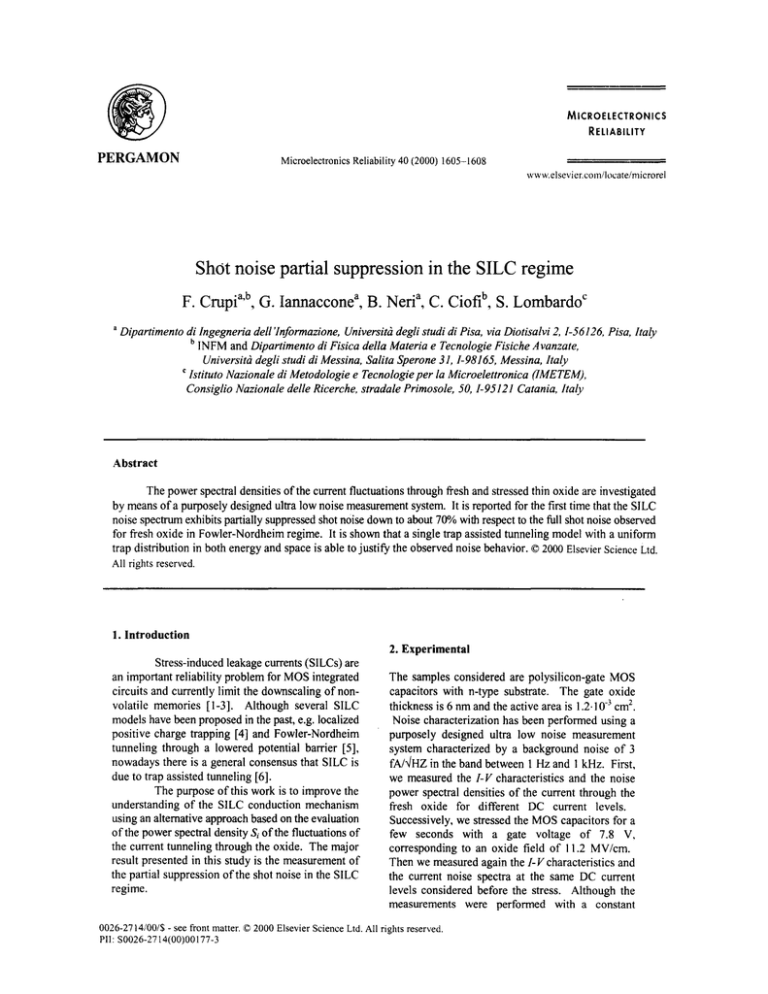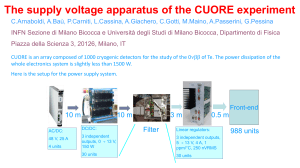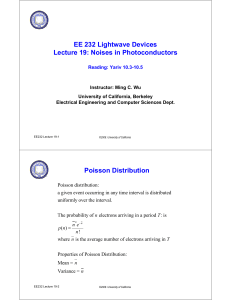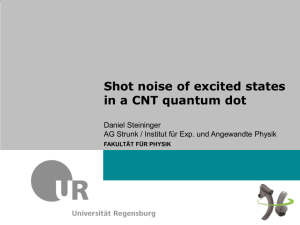
MICROELECTRONICS
RELIABILITY
PERGAMON
Microelectronics Reliability 40 (2000) 1605-1608
www.elsevier.coln/Iocate/mierorel
Shot noise partial suppression in the SILC regime
F. Crupi a'b, G. Iannaccone a, B. Neri a, C. Ciofi b, S. Lombardo c
a Dipartimento di Ingegneria dell'lnformazione, UniversitA degli studi di Pisa, via Diotisalvi 2, 1-56126, Pisa, Italy
b INFM and Dipartimento di Fisica della Materia e Tecnologie Fisiche A vanzate,
Universitgl degli studi di Messina, Salita Sperone 31, 1-98165, Messina, Italy
c Istituto Nazionale di Metodologie e Teenologie per la Microelettroniea (IMETEM),
Consiglio Nazionale delle Rieerehe, stradale Primosole, 50, 1-95121 Catania, Italy
Abstract
The power spectral densities of the current fluctuations through fresh and stressed thin oxide are investigated
by means of a purposely designed ultra low noise measurement system. It is reported for the first time that the SILC
noise spectrum exhibits partially suppressed shot noise down to about 70% with respect to the full shot noise observed
for fresh oxide in Fowler-Nordheim regime. It is shown that a single trap assisted tunneling model with a uniform
trap distribution in both energy and space is able to justify the observed noise behavior. © 2000 Elsevier Science Ltd.
All rights reserved.
I. Introduction
2. Experimental
Stress-induced leakage currents (SILCs) are
an important reliability problem for MOS integrated
circuits and currently limit the downscaling of nonvolatile memories [1-3]. Although several SILC
models have been proposed in the past, e.g. localized
positive charge trapping [4] and Fowler-Nordheim
tunneling through a lowered potential barrier [5],
nowadays there is a general consensus that SILC is
due to trap assisted tunneling [6].
The purpose of this work is to improve the
understanding of the SILC conduction mechanism
using an alternative approach based on the evaluation
of the power spectral density Si of the fluctuations of
the current tunneling through the oxide. The major
result presented in this study is the measurement of
the partial suppression of the shot noise in the SILC
regime.
The samples considered are polysilicon-gate MOS
capacitors with n-type substrate. The gate oxide
thickness is 6 nm and the active area is 1.2.10 -3 cm 2.
Noise characterization has been performed using a
purposely designed ultra low noise measurement
system characterized by a background noise of 3
fA/~HZ in the band between 1 Hz and 1 kHz. First,
we measured the I-V characteristics and the noise
power spectral densities of the current through the
fresh oxide for different DC current levels.
Successively, we stressed the MOS capacitors for a
few seconds with a gate voltage of 7.8 V,
corresponding to an oxide field of 11.2 MV/cm.
Then we measured again the 1-V characteristics and
the current noise spectra at the same DC current
levels considered before the stress. Although the
measurements were performed with a constant
0026-2714/00/$ - see front matter. © 2000 Elsevier Science Ltd. All rights reserved.
PII: S0026-2714(00)00177-3
E Crupi et al./ Microelectronics Reliability 40 (2000) 1605-1608
1606
measured Si in a range o f DC current densities for
10 4
10 .6
1 0 - 2 s ~
~ " 10
.26
10 "z
~ 10.27
10 .5
I~10.8
~
'~"-
VJ 10 -
10-8
10 -1(
2
3
4
V o l t a g e [V]
Fig. 1 Typical J- V curves of a fresh oxide and after FN
stress. The n-MOS was biased in the accumulation region.
voltage source, we checked that the variation of the
level of the DC current during a single measurement
was smaller than 1% of the corresponding mean
value. In order to obtain an almost steady-state
current in the SILC regime, the measurements have
been realized after the initial period characterized by
a current decay due to the trap-filling process [6].
3. Results and discussion
Fig. l shows the typical J-V curves
measured before and after stress in the FowlerNordheim (FN) regime. For a fresh oxide I / f noise
is observable below a few Hertz, whereas at higher
frequencies Si exhibits a plateau.
Fig.2 reports the measured plateaus for
different values of the DC current, along with the line
corresponding to the full shot noise 2ql. The perfect
fitting clearly indicates that Si for the tunnel current
through a fresh oxide shows the full shot noise value.
This result was expected as the FN conduction
mechanism presents the two necessary and sufficient
conditions to have full shot noise, i.e. the motion of
the carriers is unidirectional and uncorrelated.
Fig.3 compares S~measured before and after
FN stress for the same DC current of 500 pA. As can
be seen, shot noise in the SILC regime is partially
suppressed with respect to the full shot noise value.
An useful parameter for characterizing the degree of
suppression is the shot noise suppression factor, or
Fano factor, defined as "f = S~ / 2ql [7]. We have
[
10-29
5
1
. . . . .
Ioc = 300 PA
2.
20
8
~
40
60
I
. . . . . . . . . . . . .
80
Frequency
[Hz]
100
which the level of Si is significantly larger than the
background noise coming from the instrumentation
and the SILC
Fig. 2 Current noise spectra measured in a fresh oxide
(solid lines) corresponding to the full shot noise (dashed
lines) as a function of the DC current level. A perfect
fitting is observed.
3x10-zt
i
[
[
2x10"2~
"1-
<
~- lx10 zt
20
i
40
60
Frequency [Hz]
80
I00
Fig. 3 Power spectral densities of the current noise of a
fresh and stressed oxide corresponding to the same DC
current level (500 pA). A partial suppression of the shot
noise is observed in the stressed oxide.
component is a relevant fraction o f the total current.
As the total DC current can be written as
I=IrN+Is1Lc, where 1FNand lslm are the FN and SILC
components, respectively, and assuming that the two
components are independent, the corresponding
spectrum can be written as:
S i = 2qlFu + 7Sltc2qlstLc
(1)
where the FN component exhibits full shot noise, i.e.
y = 1, as shown in Fig. 2, and the SILC component
1607
E Crupi et al.lMicroelecttonics Reliability 40 (2000) 1605--1608
exhibits suppressed shot noise with Fano factor 7smo
Since L IFN, and Si are measured, 7smc can be readily
obtained. Fig.4 shows the mean values of 7 (a), of
the fraction of SILC ot = ISlLC/I (b) and of 7smc (c)
as a function of the total current density Jobtained in
O
an other electron with different spin, but Coulomb
repulsion would highly raise its energy); second, the
occupancy probability of a trap decreases if there are
nearby traps occupied, due to Coulomb repulsion. As
a consequence, the current pulses associated to the
4
1.0
0.91
i
i
i
•
0.8
j si -
O
c 0.7
u_ 0.6
S i ........
(a)
-4_
¢-
._o 0.8
"5
0.6
~.-6
I
kL
o 0.4
0.2
__1
-10
(b)
-10
-~ 0.9
Depth [nm]
u_ 0.8
t
O
,~ 0.7
I.L
o
""
0.6
0.5
10-7
(e)
,
,
.
. . . . . .
,
,
,
10 6
.
. . . .
Fig. 5 Band profiles for a MOS structure with the
schematic of a single trap assisted tunnel.
10 ~
Current Density [Ncm 2]
Fig. 4 Fano factor of the total current (a), fraction of SlLC
(b) and Fano factor of the SILC component (c) in a
stressed oxide as a function of the total DC current density.
The points are the average values obtained by measuring
four samples. A quite constant suppression factor is
observed in the current density measured range
same trap are negatively correlated. The effect is
quite similar to that observed in the case of resonant
tunneling diodes [8]. If the applied oxide field is
sufficiently high so that the transition rates in the
direction opposite to that of the field are negligible,
the suppression factor is related to the capture and
emission time of a trap, ze and ze, (see Fig. 5) by the
following equation [8]:
1 + (z-c/Ze) z
four samples. It is found that increasing J, 1'
increases and t~ decreases, whereas 'YSiLCis quite
constant around 0.75 in all the considered DC current
density range.
The partial suppression of the shot noise
clearly indicates some kind of correlation. This
observation allows one to exclude that SILC are due
to single tunneling events, as suggested by the
models of localized positive charge trapping and FN
through a lowered potential barrier, whereas it is
compatible with trap assisted tunneling (TAT).
Indeed, there are two factors that induce correlation
in the electron motion during TAT: first, a trap
cannot contain more than one electron at a time (the
Pauli exclusion principle would allow the presence of
~ =
(2)
(1..i,. ,ifc / ~e ) 2
It is worth noticing that Eq. 2 implies that the Fano
factor can vary between 0.5, for x¢ = ze corresponding
to a trap positioned in a fixed position in the central
region of the oxide, and 1, for a large difference
between xc and xe corresponding to a trap positioned
in one of the interfaces. Thus the 0.75 measured
value of l'smc excludes the possibility that all the
traps responsible for SILC are in a fixed position in
the central region of the oxide or at one of the
interfaces, whereas it is compatible with the
assumption of a uniform spatial trap distribution
inside the oxide. We have developed a numerical
1608
E Crupi et al./ Microelectronics Reliability 40 (2000) 1605-1608
model for the calculation of the current noise in the
SILC regime based on Eq.2. This model does not
take into account the reduction of the occupancy
probability of a trap due to the Coulomb repulsion of
the nearby occupied
traps, thus slightly
knowledge of the conduction mechanism in the SILC
regime.
Acknowledgements
This work has been supported by the Italian
National Research Council (CNR) through the
Finalized Project MADESSII.
1.0
~ 0.9
O
"5
~. 0.8
0
E
LL
0
J
References
0.7
0.6
0.5
i
10-z
i
.
.
.
.
.
.
I
i
i
i
10 .6
. . . . .
10 ~
Current Density [Ncm 2]
Fig. 6 Theoretical Fano factor of the SILC
component as a function of the total DC current
density.
underestimating the shot noise suppression.
Fig. 6 shows the computed 'YSiLC as a
function of the total current density obtained
assuming a trap distribution uniform in both energy
and space. As can be seen, the noise properties of
the SILC are well predicted, thus providing evidence
for the validity of the assumptions of our model.
4. Conclusion
It has been found that S1LC power spectral
density is characterized by a partial suppression of
the shot noise around 75%. This experimental
evidence allows one to exclude that SILC are due to
single tunnel mechanism, whereas is compatible with
trap assisted tunneling. The good agreement between
the experimental data and the results obtained by
means of a numerical calculations indicates that the
noise properties of the S1LC are well predicted by a
single trap tunneling model with a uniform trap
distribution in both energy and space. A wider
experimental characterization of the phenomenon of
the partial suppression of the shot noise is strongly
recommended in order to acquire a deeper
[1] K. Naruke, S. Taguchi, M. Wada, "Stress Induced
Leakage Current limiting to scale down EEPROM tunnel
oxide thickness", IEDM Tech. Dig., pp. 424-427, 1988
[2] J. De Blauwe, J.V. Houdt, D. Wellekens, R. Degraeve,
Ph. Russel, L. Haspeslagh, L. Deferm, G. Groeseneken,
H.E. Maes, "A new quantitative model to predict SILCrelated disturb characteristics in Flash E2pROM devices",
in IEDM Teeh. Dig., pp. 343-346, 1996
[3] J.H. Stahis and D.J. DiMaria, "Reliability projection
for ultra-thin oxides at low voltage", IEDM Tech. Dig., pp.
167-170, 1998
[4] J. Maserjian and N. Zamani, "Behavior of the Si/SiO2
interface observed by Fowler-Noedheim tunneling", J.
Appl. Phys., vol. 53, n.1, pp. 559-567, 1982
[5] K. Kassmi, J. Prom, G. Sarrabayrouse, "Electrical
conduction in MOS capacitors with an ultra-thin oxide
layer", Solid-State Electron., vol.34, p.509, i 991
[6] R. Moazzami, C. Hu, "Stress- induced current in thin
silicon dioxide films", IEDM Tech. Dig., pp. 139-142,
1992
[7] A. Van der Ziel, Noise in solid state devices and
circuits, (Wiley, New York, 1986) p. 26
[8] G. Iannaccone, M. Macucci, B. Pellegrini, "Shot
noise in resonant tunneling structures", Phys. Rev. B 55,
pp. 4539-4550, 1999



